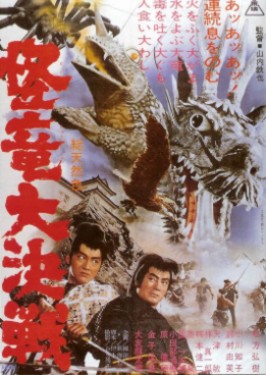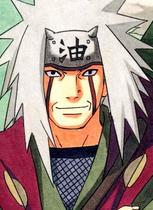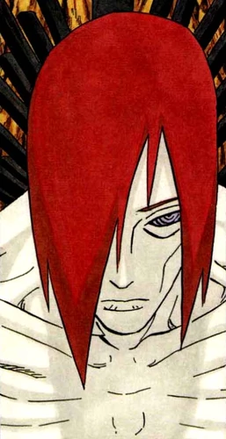
Tsunade (綱手), featured in the Japanese folktale Jiraiya Gōketsu Monogatari (児雷也豪傑物語, "The Tale of the Gallant Jiraiya"), never married and only dated one person. She mastered slug magic and could walk on water. [1] [2] [ self-published source ]

Tsunade (綱手), featured in the Japanese folktale Jiraiya Gōketsu Monogatari (児雷也豪傑物語, "The Tale of the Gallant Jiraiya"), never married and only dated one person. She mastered slug magic and could walk on water. [1] [2] [ self-published source ]
In the manga and anime series Naruto , characters named Tsunade, Jiraiya, and Orochimaru appear as three legendary ninja known as the Densetsu no Sannin (伝説の三忍).

Naruto is a Japanese manga series written and illustrated by Masashi Kishimoto. It tells the story of Naruto Uzumaki, a young ninja who seeks recognition from his peers and dreams of becoming the Hokage, the leader of his village. The story is told in two parts: the first is set in Naruto's pre-teen years, and the second in his teens. The series is based on two one-shot manga by Kishimoto: Karakuri (1995), which earned Kishimoto an honorable mention in Shueisha's monthly Hop Step Award the following year, and Naruto (1997).

Naruto Uzumaki is the titular protagonist of the manga Naruto, created by Masashi Kishimoto. He is a ninja from the fictional Hidden Leaf Village. As a boy, Naruto is ridiculed and ostracized on account of the Nine-Tailed Demon Fox—a malevolent creature that attacked Konohagakure—that was sealed away in his body. Despite this, he aspires to become his village's leader, the Hokage, in order to receive their approval. His carefree, optimistic, and boisterous personality enables him to befriend other Konohagakure ninja, as well as ninja from other villages. Naruto appears in the series's films and in other media related to the franchise, including video games and original video animations (OVA), as well as the sequel Boruto: Naruto Next Generations, where he is the Hokage, and his son, Boruto Uzumaki, is the protagonist.

Jiraiya, originally known as Ogata Shuma Hiroyuki (尾形周馬寛行), is the toad-riding protagonist of the Japanese folk tale Katakiuchi Kidan Jiraiya Monogatari. The tale was originally a Yomihon that was published in 1806–1807, and was adapted into a serialized novel that was written by different authors and published in 43 installments from 1839 to 1868; one of its illustrators was woodblock artist Kunisada. Kawatake Mokuami then wrote a kabuki drama based on the first ten parts of the novel, which premiered in Edo in 1852, starring Ichikawa Danjūrō VIII in the leading role. Since then the story has been adapted into several films, video games, manga, and has also influenced various other works.

Orochimaru (大蛇丸), featured in the Japanese folktale Jiraiya Gōketsu Monogatari, is the archenemy of the ninja Jiraiya. He was once named Yashagorō (夜叉五郎) and was one of Jiraiya's followers but was overtaken by serpent magic. Having changed his name to Orochimaru, he gained the ability to turn himself into a giant serpent. He poisoned Jiraiya and Tsunade the slug princess by pouring his venom on them as they slept, only for another follower to save the couple's lives afterwards. "The story, first recorded in 1806, was adapted into a mid-19th-century serialized novel and a kabuki drama, based on the first 10 installments, by Kawatake Mokuami, in 1852. In the 20th-century, the story was adapted in several films, in video games, and in a manga."
The Metal Hero Series is a metaseries of tokusatsu superhero TV series produced by Toei for Japanese television.

Ninja Sentai Kakuranger is a Japanese tokusatsu television series. It was Toei Company Limited's eighteenth production of the Super Sentai metaseries. It aired from February 18, 1994, to February 24, 1995, following its predecessor Gosei Sentai Dairanger and was replaced by Chouriki Sentai Ohranger. The name given to this series by Toei for international distribution is Ninja Rangers.

The Magic Serpent is a 1966 kaiju film directed by Tetsuya Yamanochi and produced and distributed by Toei Company, loosely adapting the Japanese story of Jiraiya.

Jiraiya (自来也) is a fictional character in the Naruto manga and anime series created by Masashi Kishimoto. Introduced in the series' first part, he was a student of Third Hokage Hiruzen Sarutobi and one of the three "Legendary Three Ninjas"(Legendary Sanin)—along with Orochimaru and Lady Tsunade, his former teammates. Jiraiya appears as a perverted old man who occasionally returns to the village Konohagakure, reporting the activities of Orochimaru and the organization Akatsuki. Referred to as the "Toad Sage" and "Pervy Sage", he mentors Fourth Hokage Minato Namikaze and later becomes the godfather and mentor of Minato's son, Naruto Uzumaki.
Jiraiya is the title character of the Japanese folk tale Jiraiya Gōketsu Monogatari.

Orochimaru (大蛇丸) is a fictional character from Naruto, a manga series created by Masashi Kishimoto. Orochimaru is a former ninja from the village of Konohagakure who is well known for work in wars which earned him the title of Sannin and becomes a terrorist as a means to cheat death, and built his own ninja village Otogakure. He succeeds to some extent in obtaining immortality by transferring between different host bodies, which became one of his driving motivations throughout the series as he targets Sasuke Uchiha for his genetic heritage. By the events of Boruto: Naruto Next Generations, he has seemingly redeemed himself and has sent his experiment Mitsuki to Konoha to become a ninja. Orochimaru has appeared in media outside the Naruto anime and manga, including several video games.

Naruto: Rise of a Ninja is an action adventure game for the Xbox 360 with high emphasis on fighting and platforming mechanics, like with most Naruto games, it features cel-shaded graphics. The game was developed by Ubisoft Montreal, making it the first Naruto game to be developed by a non-Japanese company. The game is specifically based on the English dubbed version of the anime. The game was released in 2007. A sequel titled Naruto: The Broken Bond was released in the following year.

Olympic Ninja Jiraiya is a Japanese television series that aired on TV Asahi and its affiliates from January 24, 1988, to January 22, 1989, lasting 50 episodes. It was the seventh installment in Toei's Metal Hero Series franchise of live-action superhero shows and the last of the Showa era. The series centers around a young ninja master named Toha Yamaji, who must face numerous ninja masters from different parts of the world by donning a special armor to become his alter-ego Jiraiya.
Kunoichi is a Japanese term for "woman". In popular culture, it is often used for female ninja or practitioner of ninjutsu (ninpo). The term was largely popularized by novelist Futaro Yamada in his novel Ninpō Hakkenden (忍法八犬伝) in 1964.
Junichi Haruta is a Japanese actor from Kitakyushu, Fukuoka Prefecture. His real name is Misao Haruta. Haruta joined the J.A.C, a theater troupe founded by Sonny Chiba, after leaving high school.

Naruto Shippuden the Movie: The Will of Fire, is a 2009 animated martial arts fantasy film and the sixth Naruto film overall and the third Naruto: Shippuden film, takes as its basis the popular anime and manga series. Released on August 1, 2009 in theaters in Japan, it uses the advertising tagline Todoke, ore-tachi no Omoi!.

Nagato, known primarily under the alias of Pain, is a fictional character in the manga and anime series Naruto created by Masashi Kishimoto. Nagato is the figurehead leader of the Akatsuki who wishes to capture the tailed beasts sealed into various people around the shinobi world. After acquiring and sealing most of the beasts within a Gedo statue, Nagato's advisor advises him to capture the Nine-Tailed Demon Fox sealed inside the series' protagonist, Naruto Uzumaki. Before leaving to capture Naruto, Nagato engages in a mortal battle with his former mentor, Jiraiya. His past as a war orphan, and his loss of his best friend are explored. Due to his traumatic experiences, which stemmed from human conflict, Nagato aims to create a new world, free from the chaos of war. Nagato also appears in the series' video games.

Road to Ninja: Naruto the Movie is a 2012 Japanese anime martial arts fantasy film based on Masashi Kishimoto's manga and anime series, Naruto. It was released in Japan on July 28, 2012. It is the first Naruto film to have Kishimoto directly involved with its production including its main story and new character designs. The story focuses on the ninjas from the Hidden Leaf Village Naruto Uzumaki and Sakura Haruno who are trapped into an alternate version of their home by the leader of the Akatsuki criminal organization Tobi, who aim to take the mystic creature Nine-Tailed Demon Fox sealed inside in the former by his parents during childbirth. The alternate Hidden Leaf Village has multiple changes from Naruto's world most notably the fact that Naruto's parents Minato Namikaze and Kushina Uzumaki are alive, challenging the protagonist into either giving into the world he always wanted or carry his parents's legacy to defeat the Akatsuki.

Naruto Shippuden: Ultimate Ninja Storm 3, known in Japan as Naruto Shippūden: Narutimate Storm 3, the fourth installment of the Ultimate Ninja Storm series, is a fighting game developed by CyberConnect2 as part of the Naruto: Ultimate Ninja video-game series based on Masashi Kishimoto's Naruto manga. It was first released for PlayStation 3 and Xbox 360 by Namco Bandai Games in March 2013 in North America and in Europe, and in April 2013 in Japan.
Jiraiya is a pseudonymous Japanese gay manga artist and illustrator. He is noted for his homoerotic, hyperreal drawings of gachimuchi men, and for his use of digital illustration in his artwork.